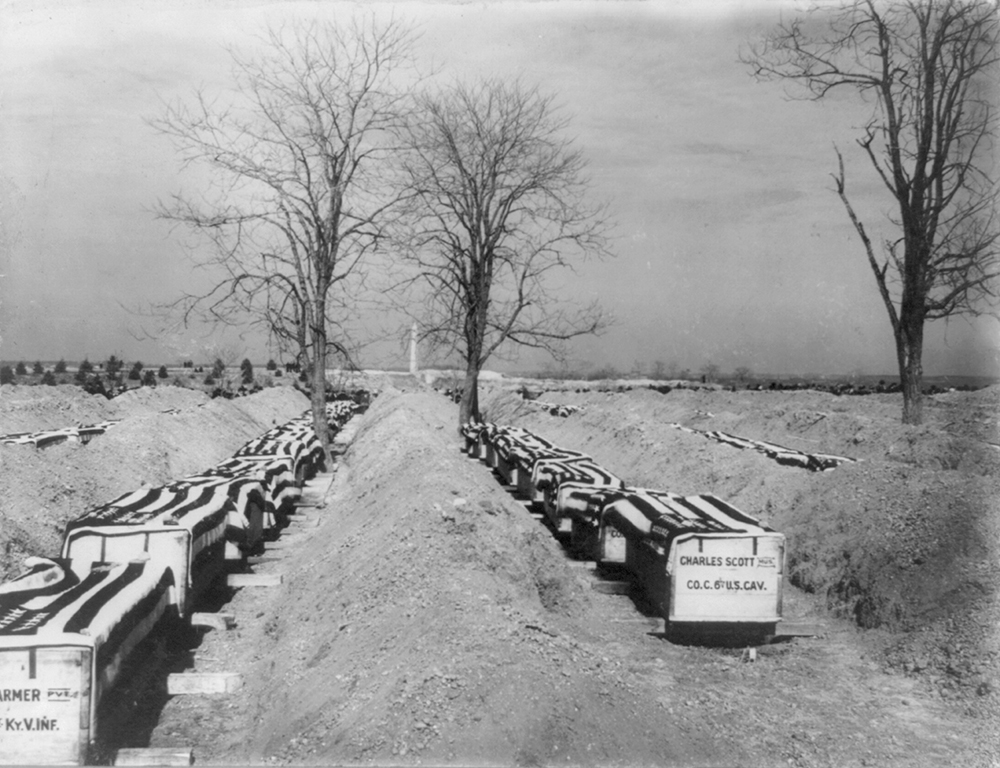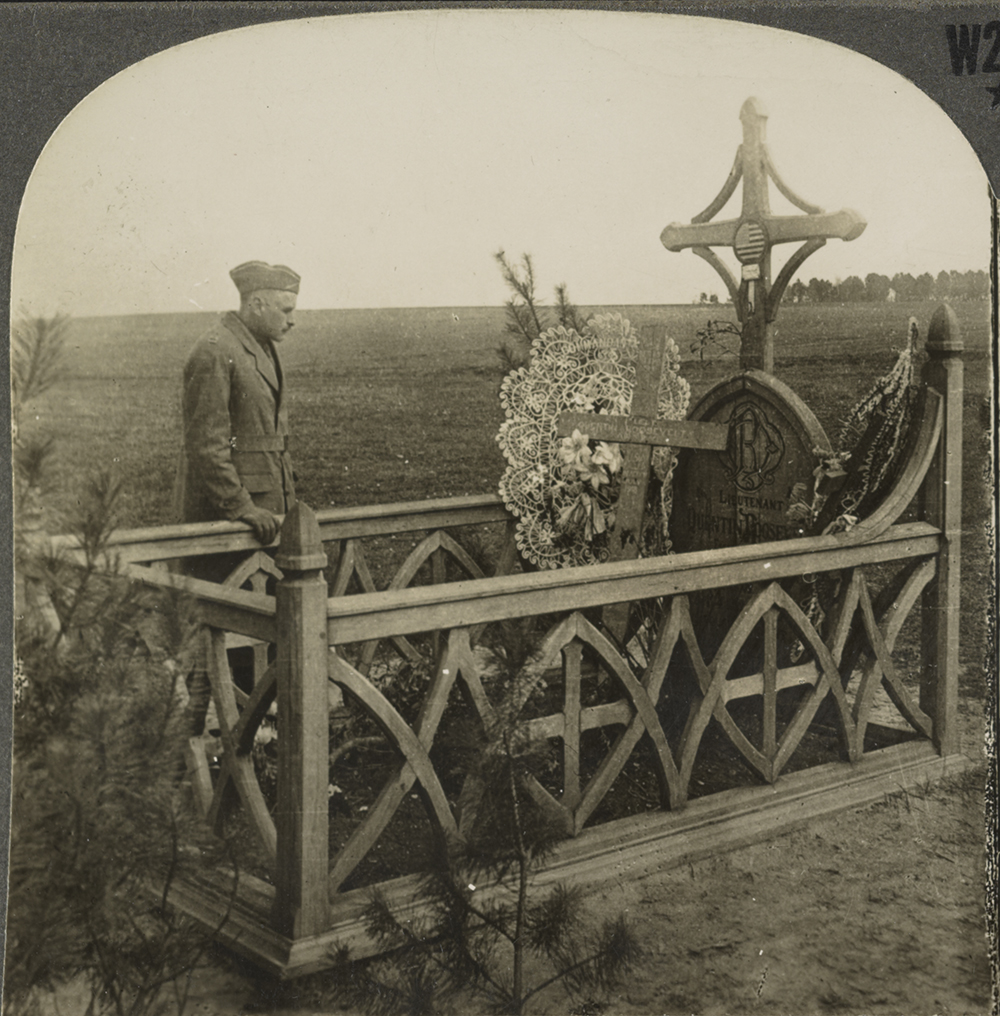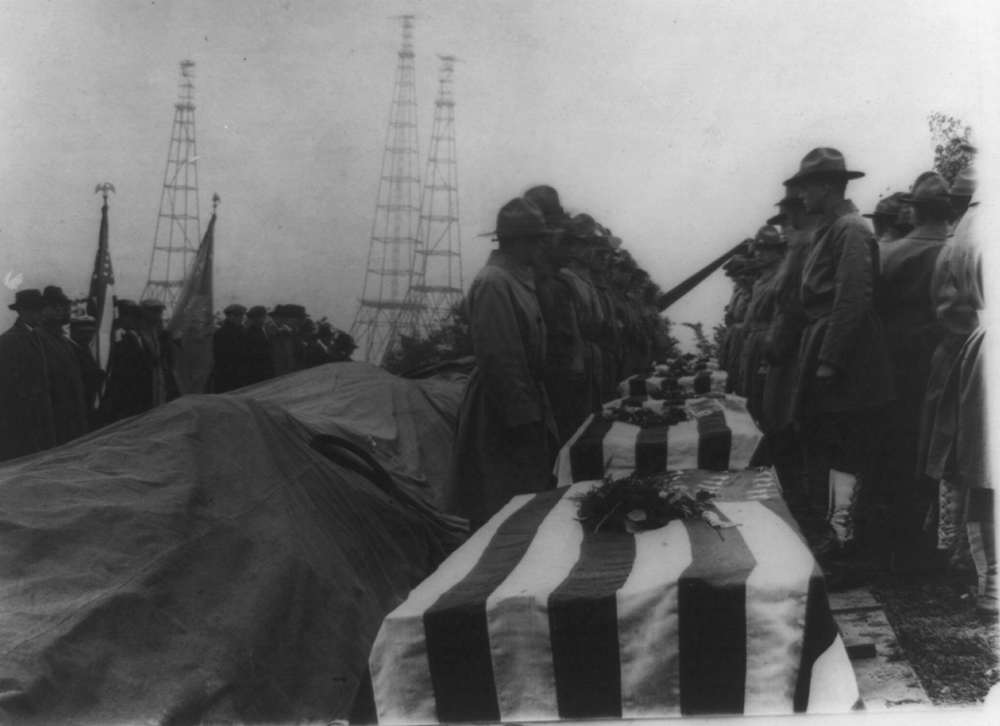
Tomb of the Unknown Soldier, Arlington National Cemetery, 1922. Photograph by Harris & Ewing. Library of Congress, Prints and Photographs Division.
The terms of the social contract regarding repatriation—the return of war dead to American soil—have evolved over the last two centuries. The American act of physical, geographic return stands in stark contrast to that of other nations, like the British and now Commonwealth nations and the French and Germans after World War I. This American sensibility regarding the need to bring home the fallen dead from foreign soil first emerged amid the devastating losses of the Civil War, with the nation bitterly divided in its sense of belonging and sovereignty. As historian Drew Gilpin Faust so deftly chronicles in This Republic of Suffering, from embalming and individuated burial practices to the creation of a comprehensive system of national cemeteries and the compunction to account for the unidentified, the war transformed the nation’s sentiment toward caring for the dead. “We still live in the world of the dead the Civil War created,” she explains. “We take for granted the obligation of the state to account for the lives it claims in its service,” and through that accounting to return remains to surviving kin.
By the Spanish-American War, when U.S. soldiers’ remains were sent back from Cuba, Puerto Rico, and the Philippines, the federal government had assumed the explicit charge of repatriating remains of service members who died on foreign soil. That practice would continue to develop in response to the wars of the twentieth century, with advances in transportation technology and, later, forensic expertise, enabling comprehensive efforts of repatriation and identification. World War I was the first major test of this nascent national tradition.

A conflict the United States belatedly joined with its American Expeditionary Force sent into battle in 1917, World War I made explicit the terms of the social contract between the government and grieving families. While “repatriation of the dead,” historian G. Kurt Piehler notes, “would certainly have to wait until the end of hostilities,” surviving relatives were given the choice of leaving their fallen kin interred overseas in a national cemetery or having the remains returned to them for burial at home, work to be carried out by the newly established Graves Registration Service. An estimated 70 percent of families chose to have them repatriated. Others decided against bringing the coffins home, including Theodore Roosevelt, who insisted that his son Quentin “lie where he fell and where the Germans buried him.” The domestic debate over repatriation or burial overseas was nested within the time’s larger divisive politics regarding America’s standing in the world and its obligation to intervene in war. Some urged the removal of the nation’s sacred dead from the iniquitous grounds of Europe so that they could not be held hostage in the likely event of another conflict there. Others argued that the war dead should remain overseas, their tombstones an enduring emblem of U.S. commitment to Europe. In the end, the families’ wishes won out. World War I’s pledge to care for the fallen thus “triggered a massive and highly controversial repatriation of war dead from the battlefields of Europe to the United States between 1919 and 1922,” historian Lisa Budreau argues. It was a “colossal task” that “set an enduring national precedent for generations.”

World War II policies followed suit, with surviving relatives again given ultimate authority over the disposition of loved ones’ remains. Piehler writes that “despite the government’s pleas against removal”—as in World War I, the military and the American Battle Monuments Commission (ABMC) saw overseas cemeteries as powerful symbols of national unity and reminders to foreign states of American sacrifices made on their behalf—“the majority of widows and parents once again wanted the bodies of their next of kin brought back to the United States.” For war dead whose remains would lay in rest overseas as well as the thousands of unknown (unidentified) service members, permanent national cemeteries were established in fourteen locations, ten of them in Europe. They were, in the words of General George C. Marshall, who took over chairmanship of the ABMC in 1949, “still conscripts,” with their “primary task…to serve national goals and objectives.” For those to be repatriated, remains were disinterred from temporary burial sites and sent to one of the various “processing stations” in the respective theaters of conflict, where American Graves Registration Service personnel checked identifications. Unnamed remains were routed to the station’s laboratory, including the Central Identification Laboratory at Schofield Barracks on Oahu, Hawaii. There, the pioneering forensic anthropologist Mildred Trotter detailed in one of her reports, “remains are either positively identified or they are not—there is no tentative identification of remains which are about to be delivered to the next of kin.”
The Korean War signaled important changes not only in the practice of remains repatriation but also in how war dead entered into the United States’ expanding role as a global power. Although that war was waged under the aegis of the United Nations, the United States led the fight and paid a steep price with its casualties. It adopted the practice of “concurrent return”—repatriating remains while the war was still being fought.
In fact, though bruited about as a policy before the war began, it took root only after public outcry arose over the preferential treatment of four-star army general Walton Walker, killed in a jeep accident in December 1950 and his remains repatriated immediately. Within a month, a temporary mortuary facility was set up in Kokura, Japan, where the American Graves Registration Services sought to identify and process remains for return to the United States. The departure from procedures during the previous world wars also reflected uncertainties about the war’s outcome and “whether future access to a U.S. military cemetery in the Republic of Korea could be guaranteed.” At the war’s end, the United Nations negotiated the exchange of war dead, an enormous undertaking dubbed Operation Glory. The Kokura lab and the postwar exchange together exposed deep-seated anxieties over foreign, and specifically Asian, enemy control of U.S. remains that had already surfaced in the wake of World War II. While Piehler explains that “there is no solid evidence to suggest that the decision not to maintain permanent cemeteries in Asia…was motivated by racism,” notions of difference stoked concerns: many Americans conceived of the enemy as communist and atheist and therefore more likely to desecrate the sacred remains of U.S. fallen.
“Americans had always been reluctant to bury their war dead in Asia,” historian Michael J. Allen notes, “and after 1950 they would never willingly do so again.”
Although recovery efforts and forensic practice had changed substantially with the Korean War, the horror of the Vietnam War, broadcast on the nightly news with its high casualties, contentious politics, and protracted duration, injected new urgency into the slogan “no man left behind.” In concrete terms, heightened repatriation efforts reflected improved logistical capacities to recover remains. While the helicopter gunship—what Viet Thanh Nguyen describes as “war machinery’s pure sex…bristling with guns and rocket pods” that “personified America, both terrifying and seductive”—represented the United States’ expanding reliance on airpower to deliver violence, the ubiquitous Huey “slicks” inserted combat troops, and “dust off” medical evacuation helicopters extracted them, living and dead. Evolving medical expertise and the positioning of triage facilities closer to the front lines, as well as improved forensic technology, meant that otherwise unrecognizable sets of remains, if found and repatriated, were more likely to be identified. It was, as Piehler notes, “one of the most elaborate efforts in the history of warfare to retrieve the bodies of those who died in combat and return them to their hometowns.”

The pledge to repatriate U.S. war dead from Southeast Asia was also distinctly grounded in wartime and postwar politics, from the domestic turmoil of the late 1960s to the war’s turning tides marked by the Tet Offensive in 1968 and eventually the peace negotiations in 1973. “Leave no man behind” cut to the core of a strained social contract. Unlike the world wars, in which the United States reluctantly entered the fray late, the conflict in Southeast Asia was a gradually escalated war of choice. The U.S. government sent its men and women, historian Christian Appy explains, “one-third draftees, one-third draft-motivated volunteers, and one-third true volunteers,” to fight in a distant land, and, following the emerging tradition of repatriation and individuated care, it was obliged to return them—and to name them. Thus, when it met with the North Vietnamese in Paris in January 1973 to negotiate an end to the war, the Nixon administration insisted on including the act of accounting in the peace accords; Article 8(b) stipulated that “the parties shall help each other to get information about those military personnel and foreign civilians of the parties missing in action, to determine the location and take care of graves of the dead so as to facilitate the exhumation and repatriation of the remains, and to take any such other measures as may be required to get information about those still considered missing in action.”
Underscoring its primacy, the United States specifically tied the POW/MIA issue and the North Vietnamese’s cooperation in accounting for U.S. missing service members to postwar aid for reconstruction, stipulated in Article 21.
The linkage had lasting effect. From Nixon to Clinton, the missing in action would become an opportune lever for U.S. administrations seeking to eschew America’s commitment to reparations and, by the 1990s, to pursue the formal normalization of diplomatic relations with the Socialist Republic of Vietnam. “For the next quarter century,” Allen notes, the Vietnamese would return in kind, insisting on “the reconstruction aid promised in Article 21 as the price for their cooperation in accounting for missing Americans.”
On the operational front, even as the peace negotiations were underway, the U.S. military was formalizing a postwar accounting initiative. It established the Joint Casualty Resolution Center (JCRC) on January 23, 1973, activated first in Saigon and relocated to northern Thailand following the signing of the peace accords. Though its investigative and recovery efforts proved largely unsuccessful, accounting for a mere sixteen sets of remains by the time communist forces seized control of Saigon on April 30, 1975, JCRC became the first step in building the United States’ contemporary MIA accounting mission. And with that effort came a new phrase: “fullest possible accounting.” In his televised address to the nation announcing the Paris Peace Accords, President Nixon pledged that “there will be fullest possible accounting for all those missing in action.”
In this evolving set of obligations to care for war dead and with the U.S. military’s increased capacity to recover and return remains, the decision to bury a Vietnam War unknown soldier at Arlington National Cemetery cut against the grain. If in the wake of World War I, the two poles of named individuals and monuments to unknowns facilitated both national and communal mourning in places like England and France, the gradually evolving enterprise of MIA accounting exposed their inherent tension in the American context.

The official interment of the Vietnam unknown at Arlington National Cemetery took place on Memorial Day, May 28, 1984. For many Vietnam War veterans, the selection and burial were long overdue; while Congress passed legislation to inter a Vietnam War Unknown shortly after the peace accords were signed and the Vietnam crypt was added to the monument in 1975, the sarcophagus itself lay empty for the next decade. For others in the POW/MIA movement, however, empty was better than filled. Many of the more politically mobilized families of the missing had fought against adding a Vietnam unknown to the tomb. To them it was another sign that the government was abandoning the search for POWs in favor of recovery efforts—giving up on the living to memorialize the dead.
Weighing it all, the Reagan administration saw the interment as a means to redefine the past conflict and revive the narrative of U.S. exceptionalism, which the war in Southeast Asia had so forcefully called into question.
As had his predecessors Harding and Eisenhower, President Reagan presided over the burial rites as the symbolic father of the nation and titular “next of kin” for its unknown lost son. In his address at Arlington that day before the “national funeral,” the president walked the fine line between acknowledging still-unmet obligations to many of the MIA families and the need to memorialize the war. He asked the country to recognize the families’ ongoing sacrifice:
They live day and night with uncertainty, with an emptiness, with a void that we cannot fathom…Vietnam is not over for them. They cannot rest until they know the fate of those they loved and watched march off to serve their country. Our dedication to their cause must be strengthened with these events today. We write no last chapters. We close no books. We put away no final memories. An end to America’s involvement in Vietnam cannot come before we’ve achieved the fullest possible accounting of those missing in action.
He then turned to the unknown, the symbol for “all our missing sons,” and invited the American public to imagine him as someone who could have easily come from their own community, perhaps even their own family: “As a child, did he play on some street in a great American city? Did he work beside his father on a farm in America’s heartland? Did he marry? Did he have children?” By honoring a Vietnam unknown, Americans could, in his words, “transcend the tragedies of the past,” as they learned to “trust each other again.” In this moment of public mourning, Reagan seized the opportunity to recast the Vietnam War as a “noble cause,” whose memory could heal rather than divide the nation.
Historian Benedict Anderson wrote that there were “no more arresting emblems of the modern culture of nationalism” than cenotaphs and tombs of the Unknown Soldiers: “Sacrilege of a strange, contemporary kind! Yet void as these tombs are of identifiable mortal remains or immortal souls, they are nonetheless saturated with ghostly national imaginings.” What a violation it must have appeared when fourteen years later, on May 14, 1998, Department of Defense officials decided to open the Vietnam War crypt and remove the remains of the Unknown Soldier for forensic analysis. In his public remarks, a far cry from Reagan’s interment speech with its attendant fanfare, Secretary of Defense William Cohen admitted the interruption was made with “profound reluctance.”
And so, behind a screen of temporary walls and meshing to block the media, the disinterment of the remains began a six-week period of intense scrutiny and painstakingly careful analysis of forensic evidence. Much was at stake. In his Washington Post opinion editorial “Why We Must Know,” poet and funeral director Thomas Lynch warned that “of course, reopened graves, like reopened wounds, seek a certain healing and run uncertain risks. Like the war that sent home this dead body and nearly 60,000 more, the right path is not well marked, the outcomes impossible to predict.”
Excerpted from What Remains: Bringing America’s Missing Home from the Vietnam War by Sarah E. Wagner, published by Harvard University Press. Copyright © 2019 by the President and Fellows of Harvard College. Used by permission. All rights reserved.
